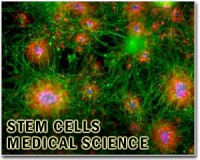 |
Houston TX (SPX) May 11, 2010 With thousands of scientists across the globe searching for ways to use adult stem cells to fight disease, there's a growing emphasis on finding the "master regulators" that guide the differentiation of stem cells. New research from Rice University and the University of Cambridge suggests that a closely connected trio of regulatory proteins fulfills that role in hematopoietic stem cells (HSCs), the self-renewing cells the body uses to make new blood cells. The results appear in the online journal PLoS Computational Biology. Working with experimentalists at Cambridge, Rice bioengineers Oleg Igoshin and Jatin Narula created a computer model that accurately describes the observed behavior of the three regulatory proteins that are collectively known as the "Scl-Gata2-Fli1 triad." "We don't yet have the experimental verification that this is the master-level regulator for HSCs, but based on our model, we can say that it has all the properties that we would expect to find in a master-level regulator," said Igoshin, an assistant professor in bioengineering at Rice. All plants and animals have stem cells, a constantly replenished feedstock of unspecialized progenitor cells that have the ability to become any of several specialized types of cell. An HSC is a type of adult stem cell that forms new blood cells. In a healthy human adult, HSCs are used to form about 100 billion new white and red blood cells each day. But HSCs also need to be able to self-renew, or make the additional stem cells needed to replenish the body's supply. Self-renewal becomes particularly important after significant blood loss through injury or when patients receive bone marrow transplants. Igoshin and Narula, a graduate student, worked with experimentalists Aileen Smith and Berthold Gottgens at the Cambridge Institute for Medical Research to create a mathematical model that accurately describes the complex interplay among the three HSC regulatory proteins in the Scl-Gata2-Fli1 triad. Based on previous studies at Cambridge, it was obvious that the triad plays an essential role in HSC development. In creating their computer model, Igoshin and Narula were able to quantify the way the three interact and thus shed light on their combined role in regulating HSCs. To qualify as a master regulator, the triad needed to meet two criteria. It had to act as a "bistable" switch, a one-way button that toggled from the "replenish HSC" state to the "differentiate" state. Second, it needed to ignore extraneous signals and throw the switch only when a signal persisted. "In examining the results from the model, we found the triad did have the characteristics of a master regulator," Narula said. "The first time it's switched on, all the cells stay on. It also handles deactivation in a controlled manner, so that some cells differentiate and get deactivated and others don't. Finally, it has the ability to discern whether or not the level of signal is present only for a short burst or for a significantly long time." Igoshin said additional experimental research is needed to verify the computer model's prediction that the Scl-Gata2-Fli1 triad is the master-level controller for HSCs. However, he said the prediction is particularly intriguing in light of previous studies that suggest other similarly wired regulatory triads are key players in other types of stem cells, including embryonic stem cells. "It's possible that this triad motif is reused elsewhere," Igoshin said. "The proteins could be different in each case, but the motif structure of their interconnections is common and may be repeated elsewhere in nature. That's one of the most intriguing aspects of this research."
Share This Article With Planet Earth
Related Links Rice University The Clone Age - Cloning, Stem Cells, Space Medicine
 More embryonic stem cell lines approved
More embryonic stem cell lines approvedBethesda, Md. (UPI) Apr 27, 2010 The U.S. National Institutes of Health said Tuesday 13 more lines of human embryonic stem cells have been made eligible for federal research funding. Among the 13 is the one most widely used by researchers, The Washington Post reported. The announcement came as some stem cell research supporters expressed concern the Obama administration was holding back stem cell research, the newspape ... read more |
|
| The content herein, unless otherwise known to be public domain, are Copyright 1995-2010 - SpaceDaily. AFP and UPI Wire Stories are copyright Agence France-Presse and United Press International. ESA Portal Reports are copyright European Space Agency. All NASA sourced material is public domain. Additional copyrights may apply in whole or part to other bona fide parties. Advertising does not imply endorsement,agreement or approval of any opinions, statements or information provided by SpaceDaily on any Web page published or hosted by SpaceDaily. Privacy Statement |